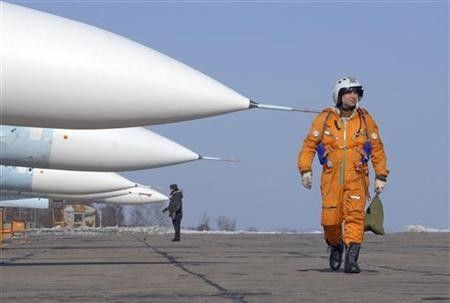Analysis: Russia turns military gaze east to counter China

With warships and missiles, Russia is flexing its muscles in the Far East in a bid to defend its position as an Asian power against China's growing might.
China's rise has forced Russia's leaders to turn their gaze eastward and reassess decades of Soviet-era planning for a land war on the European plain or the nightmare of a nuclear conflict with the United States.
The match between the world's largest energy producer, Russia, and its largest energy consumer, China, might seem ideal. But the speed at which China's military is growing presses the question: how can Moscow feed the Chinese dragon with oil and gas but still contend with its increasing power?
Russia's attempt to muscle back into the Far East, riddled with territorial conflicts and eyed by the world's top two military spenders -- the United States and China -- is Moscow's best, albeit imperfect, response to that question.
Russia is still an Asia-Pacific power, said Pavel Baev of the Peace Research Institute Oslo. Moscow's plans are definitely a signal to China that Russia takes this area seriously.
Russia's paramount leader, Prime Minister Vladimir Putin, has promised more than $651 billion in defense spending over the next decade for an annual average of around $65 billion a year. The country spent $61 billion last year.
United States core military spending was $530 billion last year, while China, the world's second largest military spender, said it put nearly $78 billion into arms in 2010, although some analysts believe that number may be higher.
Among the first arms to be sent east will be the two Mistral helicopter carriers that Moscow agreed to buy from France late last year and are expected to arrive in Russian hands in late 2013. A unit of the Russian S-400 air-defense missile system, able to counter missiles and aircraft, will also be planted in the Far East.
Deputy Defense Minister Nikolai Pankov said in an interview with Ekho Moskvy radio last month that the military was giving its Far East forces top-priority attention.
A new nuclear arms limitation treaty between Russia and the United States has reinforced statements on both sides that war between Moscow and the West is unthinkable and given the Kremlin room to send more resources east.
ENERGY DEFENSE
President Dmitry Medvedev vowed last month to deploy weapons on a group of small islands at the center of a territorial row with Japan. Medvedev visited the islands in November, followed by top officials including Defense Minister Anatoly Serdyukov.
Emphasizing its claim on the islands Soviet forces occupied at the end of World War Two, Russia has found a reason to boost its arms in the East. But some see talk focused on Japan as a bluff.
I think that spot was chosen not at random, but as a place where Russia can take a stance without taking any major risks, like upsetting China, said Baev.
Russia took over large swathes of resource-rich eastern Siberia from China through a combination of negotiation and military force in the mid-19th century.
Much of Moscow's policy toward China, Russia's largest trade partner with some $9.5 billion in bilateral trade, has been formed around fears Beijing wants that thinly populated land back, either as room for its burgeoning population or to exploit for the minerals, oil and gas it holds.
In 2008 Moscow ceded 174 square km (67 square miles) of land to Beijing on their shared border along the Ussuri and Amur Rivers, where the two powers exchanged fire in 1969, leaving nearly 60 dead.
They're still worried that China will invade Siberia one day because of the resources, Dmitry Gorenburg, a senior analyst at military and public sector think tank CNA, said in an interview last month.
Because from the Russian point of view it's a very sparsely populated area, hard to defend, very remote from the center of Russia, he said.
Beijing has alarmed neighbors with claims on a series of uninhabited islets that Japan also considers its own.
Russia is by no means looking for a fight with China, but some analysts say Moscow wants to make sure China's territorial claims do not upset a delicate balance of power in the Far East.
Russia and China commissioned the Chinese arm of the East Siberia-Pacific Ocean (ESPO) pipeline this year which is scheduled to send 300,000 barrels of crude per day to China for 20 years.
Russia's naval plans aim to keep it the world's top oil producer by protecting large offshore oil and gas holdings at Sakhalin, where a production-sharing agreement with Exxon (XOM.N) will help make up for an expected oil shortfall in west Siberia.
China has been a big buyer of Russian arms but its defense orders for Russian arms will be at best flat this year, in part due to the country's own defense industry, which analysts say has come into its own in part by copying Russian technology.
Analysts say China's own fifth-generation fighter plane, which Beijing unveiled during U.S. Defense Secretary Robert Gates' recent visit to China, is little more than a tweaked version of a Russian design.
© Copyright Thomson Reuters 2024. All rights reserved.





















